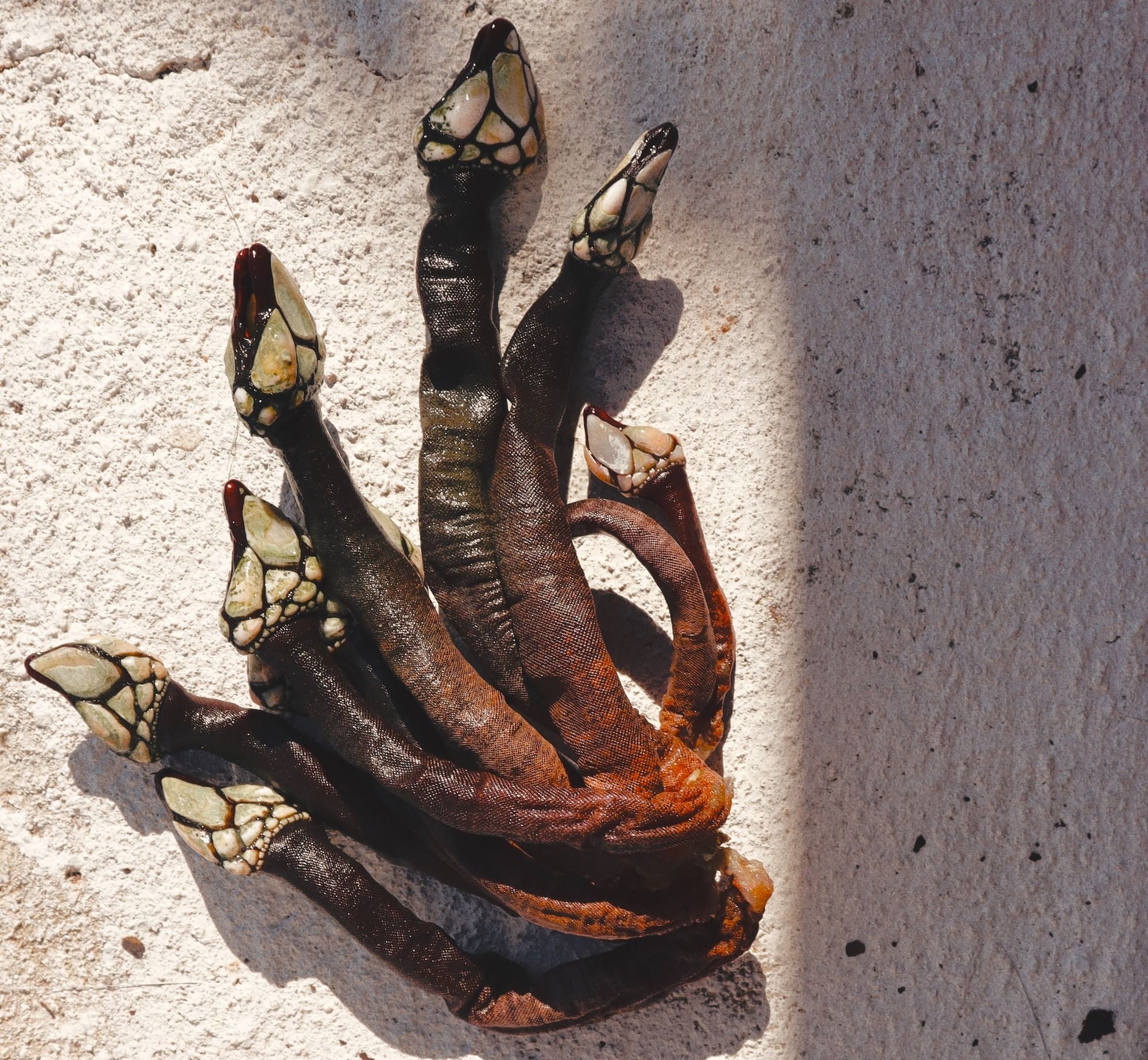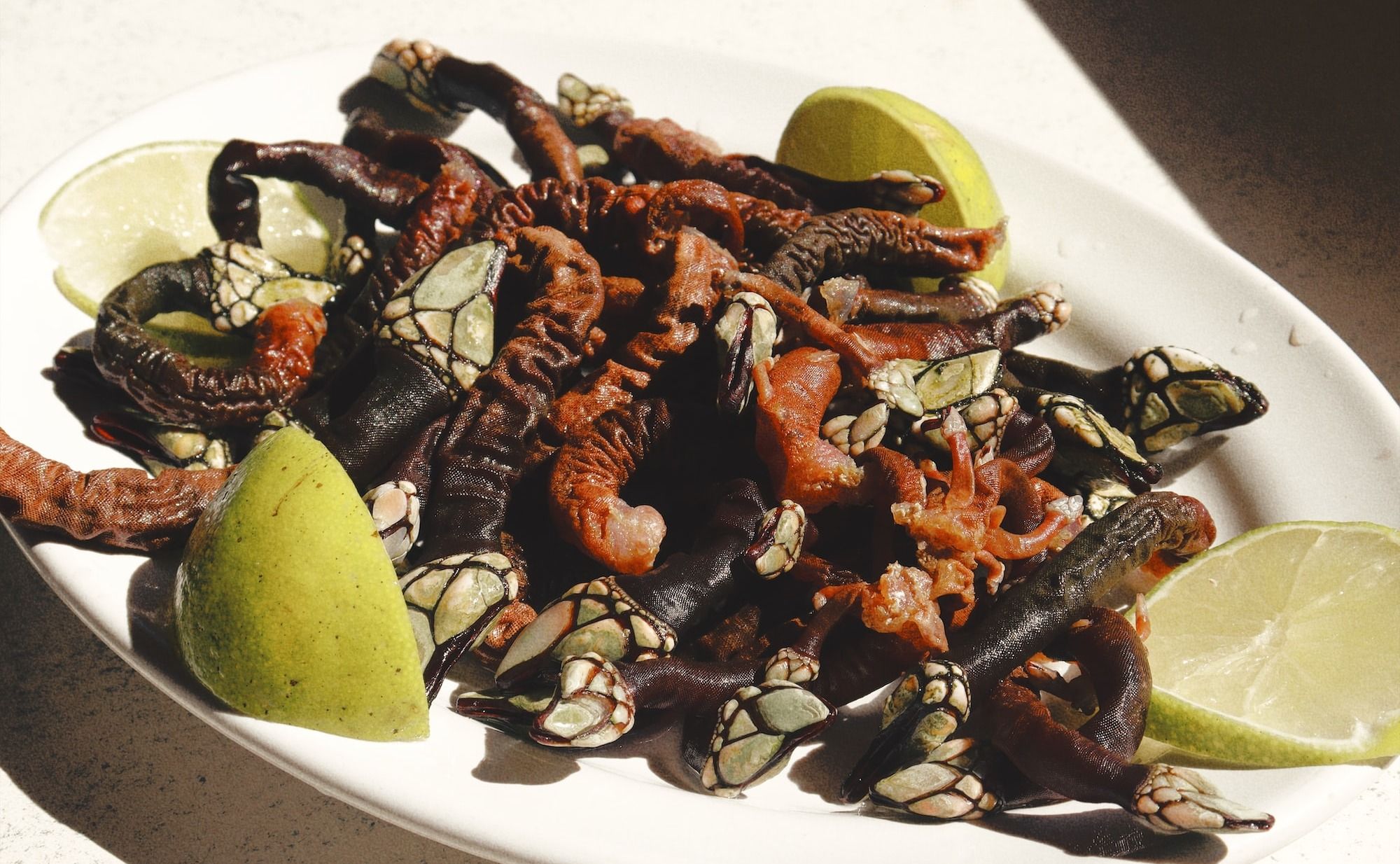Why Is Gooseneck Barnacle So Expensive?
Known as "percebes" in Spanish, gooseneck barnacles command a premium, often fetching $100 per pound, owing to their challenging harvest and unparalleled gourmet appeal.

In Europe, barnacles are termed 'percebes.' Their high value in Spain and Portugal draws fishermen to the treacherous "Death Coast" of Galicia, Spain.
Many brave these perilous waters, and some, tragically, pay the ultimate price seeking these sought-after delicacies.
What is Gooseneck Barnacle?
Pollicipes polymerus, often referred to as the gooseneck or leaf barnacle, is a specific species of stalked barnacle.
Commonly known in Portugal or Europe as "percebes," these marine crustaceans anchor themselves to hard surfaces like rocks within intertidal zones.
This shellfish appearance is quite distinct, with a long, fleshy stalk (or peduncle) topped by a hard, calcified plate. They are also members of the crustacean family alongside lobsters and crabs, rely on water movement to feed, functioning as filter feeders.
The barnacles have been a delicacy in many parts of the world, especially in Spain and Portugal
Barnacles come in two main types: those fixed within shells and the stalked variety, like gooseneck barnacles, which use an antenna-like appendage to anchor onto rocks and crevices.
Origin
This seafood is predominantly sourced from Spain's Costa da Morte. Gooseneck barnacles thrive on jagged rocks amidst turbulent waters.
Interestingly, the riskier the location, the more flavorful the barnacles. Those who specialize in collecting them are known as 'Percebeiros.'
These skilled individuals often leap from boats onto these perilous rocks and navigate underwater caverns to harvest this sought-after delicacy, as reported by CNN.
How Expensive is Gooseneck Barnacles?
This seafood ranks among the world's priciest, fetching prices from $200 in Spain and Portugal, up to an astonishing $500 per kilogram in Europe as they considered as a delicacy.
Their premium cost stems from their scarcity and the dangers fishermen endure to harvest this delicacy.

Flavor Profile
Gooseneck barnacles captivate with their distinct taste and texture. Evoking the ocean's essence, their flavor intermingles hints of lobster, clams, crab, and scallops, yet stands out with a pronounced briny touch.
Their slightly rubbery exterior conceals a tender, juicy core. Often compared in texture to octopus or the soft innards of a clam, these marine delicacies, despite their unusual appearance, are a delight for those who venture to savor them.
Why Percebes Are So Expensive?
Several factors contribute to the high price of gooseneck barnacles:

Harvesting Risks
Gathering percebes is a treacherous task. Harvesters, or "percebeiros," risk their lives as they pry barnacles off rocks amid crashing waves. They grow on treacherous rocky edges, the hardest places to reach.
The race against time is real, with collectors having a short window during low tide to harvest them. These areas are not just hard to access but are also dangerous.
Slippery rocks combined with unpredictable waves make every collection a life-risking endeavor. A somber testament to their danger is the fact that almost five individuals lose their lives each year in pursuit of these marine delicacies.
Scarcity
The best barnacles grow in the most dangerous locations, where they have access to nutrient-rich waters and aren't easily accessible. This scarcity drives up demand, making them even more of a luxury item.
The Challenge of Prying Goosenecks by Hands
Harvesting gooseneck barnacles is a formidable challenge, largely due to their tenacious grip on rocky surfaces.
These barnacles don't merely attach themselves; they anchor deeply and tightly, often nestled densely among a throng of their kin.
The close-knit clusters and their stubborn adherence make the process not only physically demanding but also a test of patience and skill.
A harvester must carefully navigate these clusters, prying each barnacle without harming its delicate flesh, all while contending with the slippery and often treacherous terrain of the shoreline.
Grading of The Gooseneck Barnacles
Marketable gooseneck barnacles have a distinct 3cm white scale and a flesh length of 3-8cm. Surprisingly, only about 10% of harvested barnacles meet these standards.
Once harvested, prompt delivery to restaurants is crucial, as freshness deteriorates quickly and freezing diminishes their quality. Grading, from A to C, considers meat content, appearance, and firmness.
Top-grade barnacles, typically 10-15cm long, command premium prices, though some connoisseurs favor the flavor of smaller specimens.

How Restaurants Serve Percebes?
At a notable restaurant in Spain, the chef presents percebes atop delicate slices of raw artichokes, generously seasoned with butter and garlic.
Meanwhile, in Toronto, they are innovatively combined with pasta, a shellfish mousse, and sea asparagus, offering a maritime twist to traditional cannelloni.
Some culinary experts prefer a simple preparation, blanching the barnacles and garnishing them with olive oil, parsley, lemon, and butter.
Gooseneck barnacles also prepared by steaming them in a concoction of white wine, chili, lemon, and aromatic herbs.
How To Eat Gooseneck Barnacle?
To enjoy percebes, hold the shell firmly, peel away the skin covering its neck, and brace yourself for a potential splash.
When you strip a gooseneck barnacle of its outer layer, it often releases a jet of salty water. If you happen upon a tiny goose within, it seems those ancient naturalists might have been onto a curious truth.
Interesting Facts:
- Culinary Delight: In Spain, percebes are often simply boiled in brine and served as is, allowing their natural flavors to shine.
- An Indicator Species: Gooseneck barnacles are also considered an indicator species, meaning their presence or absence can indicate the health of a marine ecosystem. A thriving barnacle population can signal a healthy marine environment.
- Age Indicators: The size of a barnacle can often indicate its age. Larger barnacles tend to be older. However, size isn't always an indicator of flavor; in fact, some gourmets prefer the taste of younger, smaller barnacles.
- Ancient Creatures: Barnacles have been around for millions of years, and they have close relatives that date back to the Paleozoic era.
In Conclusion
Gooseneck barnacles might strike you with their peculiar appearance, yet they're an indulgent delicacy worth exploring.
If you're on the hunt for a distinct culinary experience or a taste of the uncommon, venture into the world of gooseneck barnacles.
While their appearance might remind you of otherworldly beings, their unparalleled taste ensures they hold a place on the gourmet's plate time and time again.


